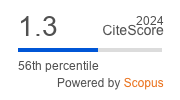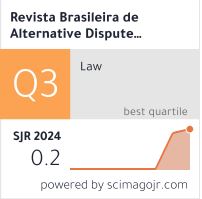Using predictive analytics systems to resolve a legal dispute
DOI:
https://doi.org/10.52028/rbadr.v6.i12.ART02.RUParole chiave:
formalization of natural language constructions, inaccuracy of solutions, algorithms, self-learningAbstract
Increasingly, in the mass media we hear about examples of using predictive analytics systems to obtain solutions to legal disputes. However, from the viewpoint of legal regulation, the question arises: Can we consider a solution proposed by the system to be final and legally significant, or just one of a possible set of solutions? In the scientific literature analyzing the prospects for such systems application, a parallel with legal principles is drawn. Researchers come to disappointing predictions about possible risks to human rights and freedoms if the solutions proposed by predictive systems are approved without human participation. In our study, we came to the following conclusions. Firstly, at the moment of technological development, intelligent systems cannot explain why they make a certain decision. Secondly, based on the fact that the system’s decision-making is not transparent, it is incorrect to assume that programmers or developers replace the judge. The role of programmers and developers of an intelligent system model is very important, but purely technical. Thirdly, the problem of inaccuracy of the system’s decisions refers only to the stage of the system training. The higher the quality of the datasets and the more data sets there are, the more accurate the decision made by this technology will be. That is why, forming correct datasets is an independent and very difficult technological task.
Riferimenti bibliografici
AL Interview: Ravel and the AI Revolution in Legal Research. https://www.artificiallawyer.com/2017/01/23/al-interview-ravel-and-the-ai-revolution-in-legal-research
Algorithm Helps New York Decide Who Goes Free Before Trial. https://www.wsj.com/articles/algorithm-helps-new-york-decide-who-goes-free-before-trial-11600610400?mod=searchresults&page=1&pos=1.
Algorithmic Realism: Expanding the Boundaries of Algorithmic Thought. In Conference on Fairness, Accountability, and Transparency (FAT* ‘20), January 27–30, 2020, Barcelona, Spain.
BRAUNEIS R., GOODMAN E.P. Algorithmic Transparency for the Smart City, The Yale Journal of Law & Technology, 20, P. 103-176, 2018.
CALO R. Robotics and the lessons of cyberlaw, California Law Review, 103(3), P. 513-563, 2015. https:// doi.org/10.2139/ssrn.2402972.
CONCEPT of development of machine-readable law technologies (approved by the Government Commission on digital development and the use of information technologies for improving the quality of life and business environment, Minutes of 15.09.2021 No. 31) (The document was not published). SPS “ConsultantPlus”.
Courts plan to use artificial intelligence in drafting decisions. https://rg.ru/2023/05/25/robot-pomozhet-rassudit.html.
DORAN D., SCHULZ S., BESOLD T.R. What does explainable AI really mean? A new conceptualization of perspectives, 2017. arXiv preprint arXiv:1710.00794.
ERAHTINA O.S. Approaches to Regulating Relations in the Sphere of Developing and Using the Artificial Intelligence Technologies: Features and Practical Applicability, Journal of Digital Technologies and Law, 1(2), P. 421–437, 2023. https://doi.org/10.21202/jdtl.2023.17.
FERREIRA D. B., GROMOVA E. A. Hyperrealistic Jurisprudence: The Digital Age and the (Un)Certainty of Judge Analytics, International Journal for the Semiotics of Law, 36(6), P. 2261–2281, 2023.
GROMOVA E., BRANTES FERREIRA D. On the Way to BRICS+ Digital Sovereignty: Opportunities and Challenges of a New Era. BRICS Law Journal;11(3), P. 54-69, 2024.
HART H.L.A. Punishment and responsibility. Oxford University Press, 1968.
HOLLAND S., HOSNY A., NEWMAN S., JOSEPH J., CHMIELINSKI K. The dataset nutrition label: A framework to drive higher data quality standards. arXiv preprint arXiv:1805.03677, 2018.
KHARITONOVA Yu.S. Legal Means of Providing the Principle of Transparency of the Artificial Intelligence, Journal of Digital Technologies and Law, 1(2), P. 337–358, 2023. https://doi.org/10.21202/jdtl.2023.14.
KONSTANTINOV P.D. Influence of information technologies on principles of civil process (Comparative legal research on the example of Russia and France), major 5.1.3 – Private-legal (civilistic) sciences (legal sciences). Abstract of Cand. Sci. (Law) thesis. Ekaterinburg, 2022. https://ургюу.рф/science/dissovet/file/base/5/561/dissert_dl.pdf.
KOVALEV S.M., OLGEIZER I.A., SUKHANOV A.V., KORNIENKO K.I. Identification of Critical States of Technological Processes Based on Predictive Analytics Methods, Automation and Remote Control, Vol. 84, No. 4, P. 424–433, 2023. DOI 10.1134/S0005117923040100. EDN QRJWPX.
LESIV B.V. Predictability of law and prediction of judicial decisions in the doctrine of O. Holmes, Justice, Vol. 5, No. 2, P. 43–66, 2023. DOI 10.37399/2686-9241.2023.2.43-66. EDN TNJGSG.
MATTHIAS A. The responsibility gap: Ascribing responsibility for the actions of learning automata, Ethics and Information Technology, 6(3), P. 175–183, 2004. https://doi.org/10.1007/s10676-004-3422-1
MEETING between Mikhail Mishustin and Maksim Shaskolsky, Head of the Federal Antimonopoly Service. URL: http://government.ru/news/44429/ (access date: 26.07.2022).
MOATS D., SEAVER N. “You Social Scientists Love Mind Games”: Experimenting in the “divide” between data science and critical algorithm studies, Big Data & Society 6, 1, 2019, 2053951719833404. https://doi.org/10. 1177/2053951719833404.
O’NEIL C. Weapons of Math Destruction: How Big Data Increases Inequality and Threatens Democracy. Broadway Books, 2017.
OBAID O.I., ALI A.H., YASEEN M.G. Impact of Chat GPT on Scientific Research: Opportunities, Risks, Limitations, and Ethical Issues, Iraqi Journal for Computer Science and Mathematics 4(4), 2023. DOI: 10.52866/ijcsm.2023.04.04.002.
OBERMEYER Z., POWERS B., VOGELI Ch., MULLAINATHAN S. Dissecting racial bias in an algorithm used to manage the health of populations, Science 366, 6464, P. 447-453, 2019. https://doi.org/10.1126/science.aax2342.
PASQUALE F. The Black Box Society. Harvard University Press, 2015. https://doi.org/10.4159/harva rd.9780674736061.
PREDICTIVE analytics in civil litigation. https://pro-sud-123.ru/news/prediktivnaya-analitika-v-grazhdanskom-sudoproizvodstve.
ROADMAP for the development of “end-to-end” digital technology “Neurotechnologies and Artificial Intelligence” (The document was not published). https://digital.gov.ru.
SAMSONOVA M.V., STRELTSOVA E.G., CHAIKINA A.V. et al. Digital technologies in civil and administrative court proceedings: practice, analytics, perspectives. Moscow: Infotropic Media, 2022.
SANTONI de SIO F., MECACCI, G. Four Responsibility Gaps with Artificial Intelligence: Why they Matter and How to Address them, Philos. Technol., 34, P. 1057-1084, 2021. https://doi.org/10.1007/s13347-021-00450-x.
SCHERER M. Artificial Intelligence and Legal Decision-Making: The Wide Open? Study on the Example of International Arbitration, Queen Mary School of Law Legal Studies Research Paper No. 318/2019, May 22, 2019. SSRN: https://ssrn.com/abstract=3392669.
SHAPING the future of business marketing: unveiling the potential of predictive analytics and predictive intelligence. International Research Journal of Modernization in Engineering Technology and Science, 2023. DOI 10.56726/irjmets46344. EDN EQXCDO.
SLAVIN B. Prospects of creating a strong artificial intelligence, Open Systems. DBMS, No. 1, P. 13–17, 2024. DOI 10.51793/OS.2024.25.57.003. EDN LSLOEN.
STEPANOVA N.A. Classification of errors made in criminal proceedings, Legal Science and Law Enforcement Practice, No. 1(35), P. 23–30, 2016. EDN XBIAPR.
STILGOE J. Machine learning, social learning and the governance of self-driving cars, Social Studies of Science, 030631271774168, 2017. https://doi.org/10.1177/0306312717741687.
STILGOE J. Who Killed Elaine Herzberg? In Who’s Driving Innovation? P. 1–6, 2020. Springer International Publishing. https://doi.org/10.1007/978-3-030-32320-2_1.
TAMANAHA B.Z. Introduction. In Beyond the Formalist-Realist Divide: The Role of Politics in Judging, P. 1–10, 2010. Princeton University Press. http://www.jstor.org/stable/j.ctt7rm95.4.
Why Lex Machina’s Legal Analytics Are The Best. https://lexmachina.com.
ZHAROVA A. Ensuring the information security of information communication technology users in Russia, International Journal of Cyber Criminology, Vol. 13, No. 2, P. 255–269, 2019. DOI 10.5281/zenodo.3698141. EDN LTMESV.
ZHAROVA A. The protect mobile user data in Russia, International Journal of Electrical and Computer Engineering, Vol. 10, No. 3, P. 3184–3192, 2020. DOI 10.11591/ijece.v10i3.pp3184-3192.EDN JUZBOH.
ZHAROVA A., ELIN V., PANFILOV P. (2019). Introducing artificial intelligence into law enforcement practice: The case of Russia, Annals of DAAAM and Proceedings of the International DAAAM Symposium, Zadar, Vol. 30, P. 688–692, October 23–26, 2019. Zadar. DOI 10.2507/30th.daaam.proceedings.094. EDN OSFIVO.
Downloads
Pubblicato
Fascicolo
Sezione
Licenza
Copyright (c) 2024 Revista Brasileira de Alternative Dispute Resolution - Brazilian Journal of Alternative Dispute Resolution - RBADR

TQuesto lavoro è fornito con la licenza Creative Commons Attribuzione 4.0 Internazionale.
No royalties or other compensation shall be due for the publication of the works.
The opinions expressed by the authors of the articles and reviews are their sole responsibility.









